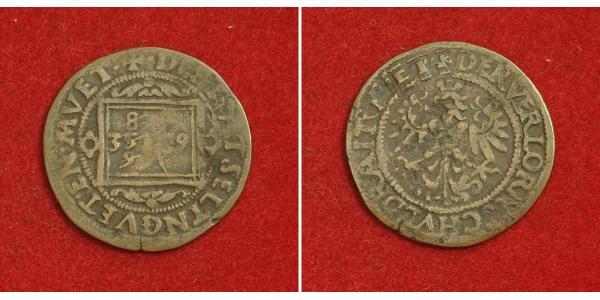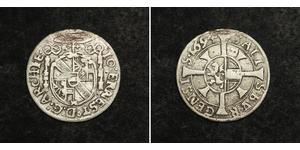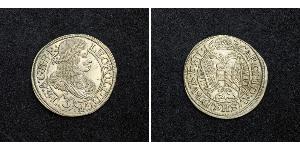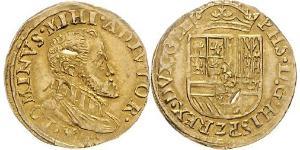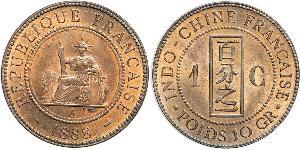(sold for $19.0)
1520, Emperor Maximilian I. Copper Counter Token (Rechenpfennig). Hall mint!
Mint Year: 1518
Condition: F-VF
Mint Place: Hall (Tirol)
References: Neuman 1329. R!
Denomination: Counter Token (Rechenpfennig)
Diameter: 23mm
Material: Copper
Weight: 2.28gm
Obverse: Square table with numerals within foliage.
Legend: + DER . VERLORN . SCHVLD . RAITP . TVET
Reverse: Crowned heraldic eagle of Tyrol within inner circle.
Legend: + DER . HAT . SELTEN . GVETEN . MVET
em>.
Maximilian I of Habsburg (22 March 1459 – 12 January 1519), the son of Frederick III, Holy Roman Emperor and Eleanor of Portugal, was King of the Romans from 1493 and Holy Roman Emperor from 1508 until his death. He had ruled jointly with his father for the last ten years of his father's reign, from circa 1483. He expanded the influence of the House of Habsburg through both war and marriage, but also lost the Austrian territories in today's Switzerland in the battle of Dornach 22 July 1499, where the Swiss won a final decisive victory. Emperor Maximilian I had no choice but to agree to a peace treaty signed on 22 September 1499 in Basel granting the Swiss Confederacy independence from the Holy Roman Empire. He is often referred to as "The Last Knight".
By marrying his son Philip to then-Crown Princess Joanna of Castile in 1498, Maximilian established the Habsburg dynasty in Spain and allowed his grandson Charles to hold the throne of both León-Castile and Aragon, therefore causing him to be the first de jure King of Spain. Having outlived his father Philip, Charles succeeded Maximilian as Holy Roman Emperor in 1519, and thus ruled both the Holy Roman Empire and the Spanish Empire simultaneously.
Maximilian governed his first wife's vast inheritance in the Low Countries, and he prosecuted a war over them with Louis XI, King of France on her behalf. Upon the Duke of Burgundy's death in 1477, the Duchy of Burgundy had been claimed by the French crown under Salic Law. Louis further attempted to expand his control into the Burgundian Netherlands. Mary, who was only 20 and yet unmarried, refused a proposed marriage to the Dauphin as a way to settle the dispute, and when she married Maximilian less than a year after her father's death, she used his power to try to take back the parts of her father's lands Louis had acquired. Maximilian was successful in the war and in stabilizing the Netherlands, but some of the Netherland provinces were hostile to him; when Mary died unexpectedly in March 1482, they signed a treaty with Louis in 1482 which forced Maximilian to give Franche-Comté and Artois to Louis. Maximilian continued to govern Mary's remaining inheritance in the name of their young son, Philip the Handsome. After the regency ended, Maximilian and Charles VIII exchanged these two territories for Burgundy and Picardy in the Treaty of Senlis (1493). Thus ultimately much of the Netherlands became and remained a Habsburg possession.
Elected King of the Romans (Rex Romanorum) 16 February 1486 in Frankfurt am Main at his father's initiative and crowned on 9 April 1486 in Aachen, Maximilian also stood at the head of the Holy Roman Empire upon his father's death in 1493. After he married Bianca Maria Sforza, a daughter of the Duke of Milan on 16 March 1494, Maximilian sought to expand his power in parts of Italy. This brought French intervention in Italy, inaugurating the prolonged Italian Wars. He joined the Holy League to counter the French and lost, but after his death the Empire ultimately won. Maximilian was also forced to grant independence to Switzerland, where he had tried to re-establish the lost Habsburg dominance.
He is possibly best known for leading the 1495 Reichstag at Worms which concluded on the Reichsreform ("Imperial Reform"), reshaping much of the constitution of the Holy Roman Empire. In the 1499 Treaty of Basel, Maximilian was forced to acknowledge the de facto independence of the Swiss confederacy from the Empire as a result of the Battle of Dornach.
In 1508, Maximilian, with Pope Julius II's assent, took the title of Erwählter Römischer Kaiser ("Elected Roman Emperor"), thus ending the centuries-old custom that the Holy Roman Emperor had to be crowned by the pope.
As part of the Treaty of Arras, Maximilian betrothed his three-year-old daughter Margaret to the Dauphin (later Charles VIII), son of his adversary Louis XI. Louis had attempted seven years earlier to arrange a betrothal between the Dauphin and Margaret's mother, Mary. Under the terms of Margaret's betrothal, she was sent to Louis to be brought up under his guardianship. Despite the death of Louis in 1483, shortly after Margaret arrived in France, she remained at the French court. The Dauphin, now Charles VIII, was still a minor, and his regent until 1491 was his sister, Anne of France. Anne's first betrothal, to the Duke of Lorraine, had ended when the Duke broke it off in order to pursue Mary of Burgundy (and died shortly afterwards). Despite Margaret's betrothal and continued presence at the French court, Anne arranged a marriage between Charles and Anne of Brittany. She, in turn, had been betrothed in 1483, and actually married by proxy in 1491, to Maximilian himself, but Charles and his sister wanted her inheritance for France. The final result of all of these machinations was that Charles repudiated his betrothal to Margaret when he came of age in 1491, invaded Brittany, forced Anne of Brittany to repudiate her unconsummated marriage to Maximilian, and married her. (They had four children who all died in infancy, and after Charles died, his widow married his cousin and successor, Louis XII.) Margaret still remained in France until 1493, when she was finally returned to her father. She married twice more.
In 1493, Maximilian contracted another marriage for himself, this time to the daughter of the Duke of Milan, whence ensued the lengthy Italian Wars with France. Thus Maximilian through his own marriages (and attempted marriage) sought to extend his sphere of influence against that of France. The marriages he arranged for both of his children more successfully fulfilled the same goal, and after the turn of the sixteenth century, his matchmaking focused on his grandchildren, for whom he looked opposite France towards the east.
In order to reduce the growing pressures on the Empire brought about by treaties between the rulers of France, Poland, Hungary, Bohemia, and Russia, as well as to secure Bohemia and Hungary for the Habsburgs, Maximilian I met with the Jagiellonian kings Ladislaus II of Hungary and Bohemia and Sigismund I of Poland at the First Congress of Vienna in 1515. There they arranged for Maximilian's granddaughter Mary to marry Louis, the son of Ladislaus, and for Anne (the sister of Louis) to marry Maximilian's grandson Ferdinand(both grandchildren being the children of Philip the Handsome, Maximilian's son, and Juana la Loca of Castile). The marriages arranged there brought Habsburg kingship over Hungary and Bohemia in 1526. Both Anne and Louis were adopted by Maximilian following the death of Ladislaus. These political marriages were summed up in the following Latin elegiac couplet: Bella gerant alii, tu felix Austria nube/ Nam quae Mars aliis, dat tibi regna Venus, "Let others wage war, but thou, O happy Austria, marry; for those kingdoms which Mars gives to others, Venus gives to thee."
In 1501, Maximilian fell from his steed. The accident badly injured his leg, which caused him pain for the rest of his life. Some historians have suggested that Maximilian was "morbidly" depressed: From 1514, he travelled everywhere with his coffin. Maximilian died in Wels, Upper Austria, and was succeeded as Emperor by his grandson Charles V, his son Philip the Handsome having died in 1506. Although he is buried in the Castle Chapel at Wiener Neustadt, a cenotaph tomb for Maximilian is located in the Hofkirche, Innsbruck.
Maximilian was a keen supporter of the arts and sciences, and he surrounded himself with scholars such as Joachim Vadian and Andreas Stoberl (Stiborius), promoting them to important court posts. His reign saw the first flourishing of the Renaissance in Germany. He commissioned a series of three monumental woodblock prints - The Triumphal Arch (1512–18, 192 woodcut panels, 295 cm wide and 357 cm high - approximately 9'8" by 11'8½"), and a Triumphal Procession (1516–18, 137 woodcut panels, 54 m long) which is led by a Large Triumphal Carriage (1522, 8 woodcut panels, 1½' high and 8' long), created by artists including Albrecht Dürer, Albrecht Altdorfer and Hans Burgkmair.
Maximilian had a great passion for armour, not only as equipment for battle or tournaments but as an art form. The style of armour that became popular during the second half of his reign featured elaborate fluting and metalworking, and became known as Maximilian armour after the Emperor. Maximilian armour emphasized the details in the shaping of the metal itself, rather than the etched or gilded designs popular in the Milanese style. Maximilian also gave a bizarre jousting helmet as a gift to King Henry VIII - the helmet's visor featured a human face, with eyes, nose and a grinning mouth, and was modeled after the appearance of Maximilian himself. It also sported a pair of curled ram's horns, brass spectacles, and even etched beard stubble.
Maximilian had appointed his daughter Margaret as both Regent of the Netherlands and the guardian and educator of his grandsons Charles and Ferdinand (their father, Philip, having predeceased Maximilian), and she fulfilled this task well. Through wars and marriages he extended the Habsburg influence in every direction: to the Netherlands, Spain, Bohemia, Hungary, Poland, and Italy. This influence would last for centuries and shape much of European history.

|
Posted by:
anonymous 2015-01-23 |

